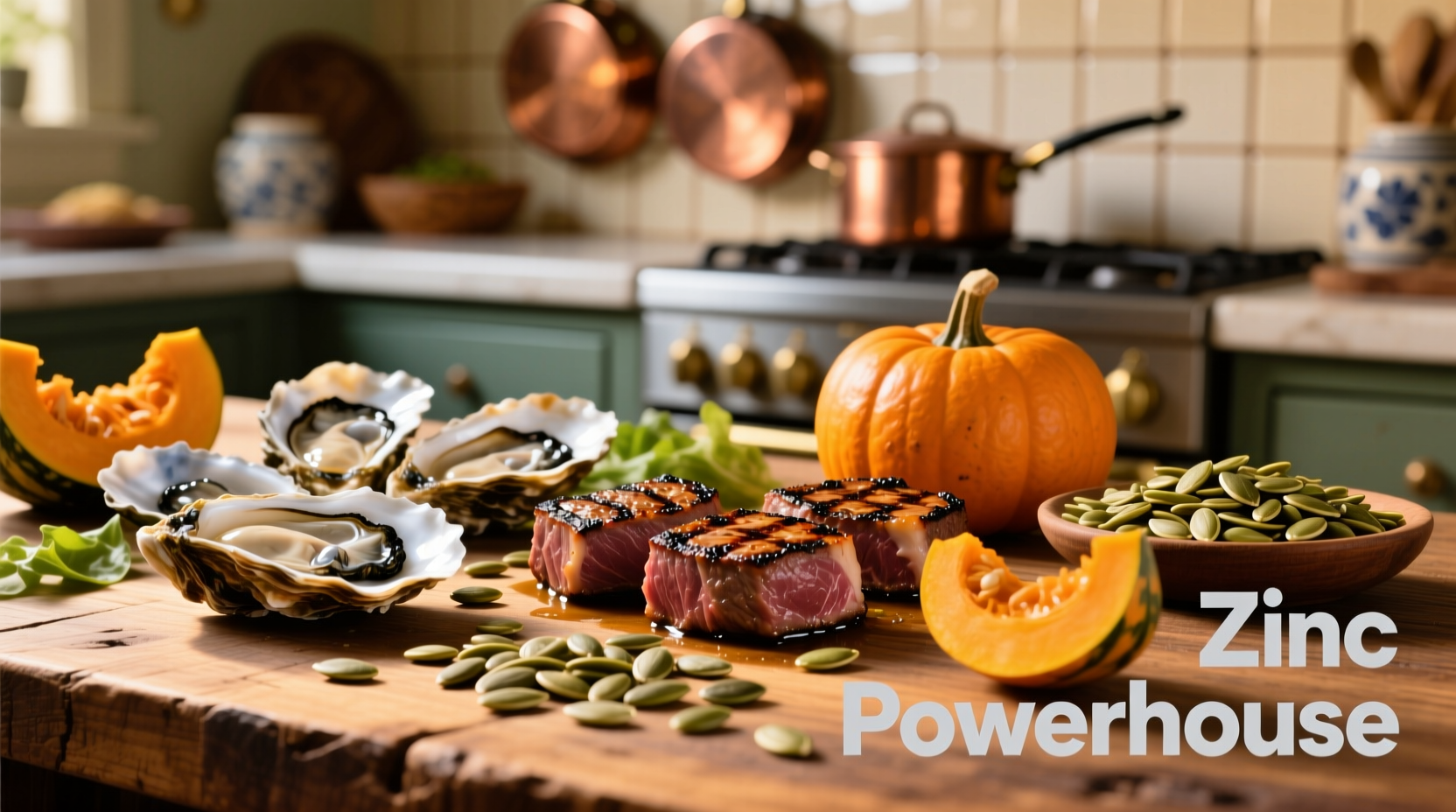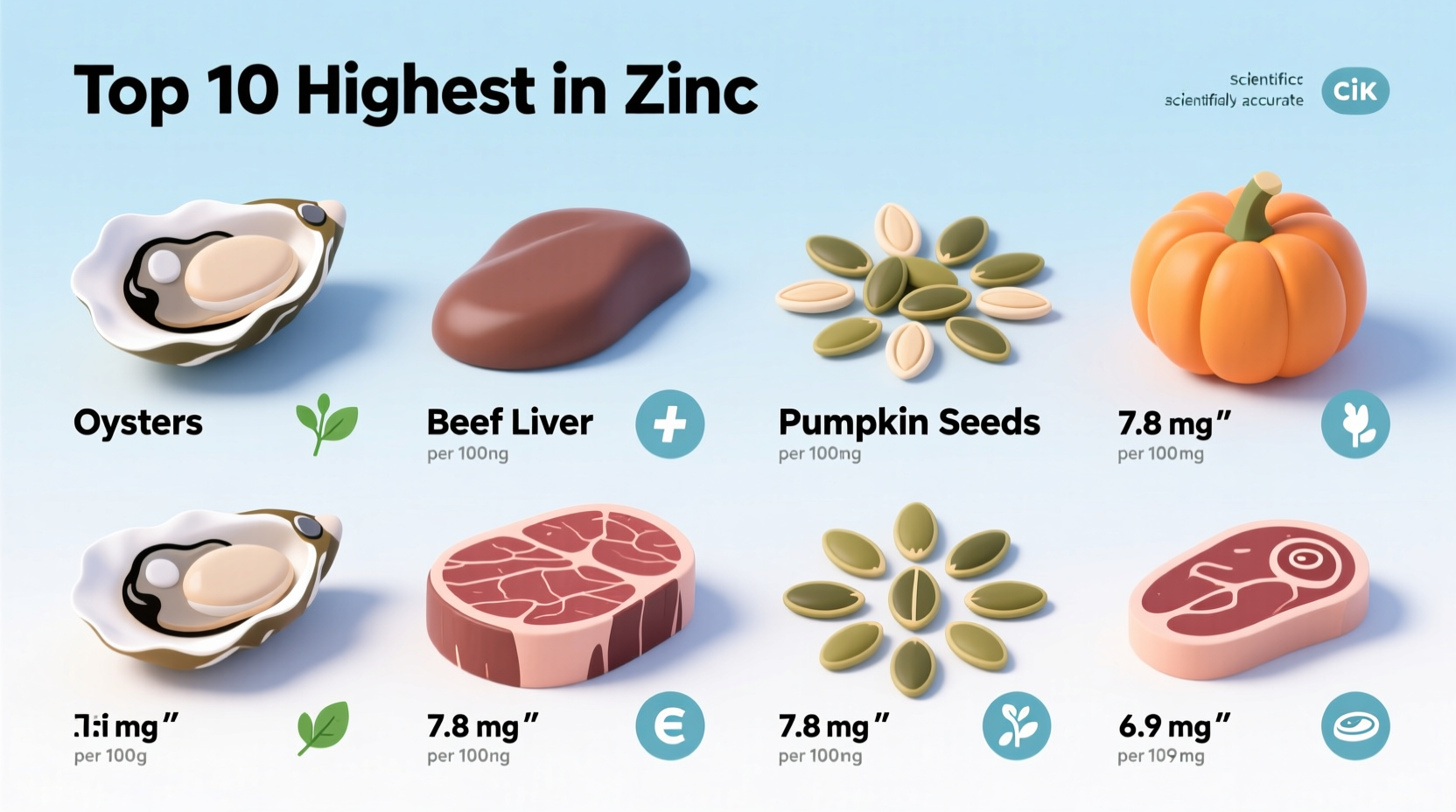The top foods highest in zinc are oysters (providing over 500% of your daily value in just 3 ounces), followed by beef chuck roast, Alaska king crab, and fortified breakfast cereals. Just 6 medium oysters deliver approximately 32 mg of zinc, far exceeding the recommended daily intake of 8-11 mg for adults. Other excellent sources include pumpkin seeds, lentils, and chickpeas for plant-based options.
Discover which zinc-rich foods can boost your immune function, support wound healing, and maintain your sense of taste and smell. This comprehensive guide reveals the top dietary sources of zinc with precise measurements, helping you optimize your intake whether you follow an omnivorous, vegetarian, or vegan diet.
Why Zinc Matters for Your Health
Zinc plays a critical role in over 300 enzymatic reactions in your body. According to the National Institutes of Health, this essential mineral supports:
- Immune system function - zinc deficiency can reduce your ability to fight infections
- Protein synthesis and DNA formation
- Wound healing processes
- Normal growth and development during pregnancy, childhood, and adolescence
- Maintaining your sense of taste and smell
Certain populations need to pay special attention to zinc intake, including vegetarians (who may need up to 50% more due to lower bioavailability from plant sources), pregnant women, athletes with high sweat losses, and older adults with reduced absorption.
Top Zinc-Rich Foods by Category
| Food | Serving Size | Zinc (mg) | % Daily Value* |
|---|---|---|---|
| Oysters, cooked | 3 ounces | 32.0 | 291% |
| Beef chuck roast | 3 ounces | 7.0 | 64% |
| Alaska king crab | 3 ounces | 6.5 | 59% |
| Fortified breakfast cereals | 1 serving | 3.8 | 35% |
| Pumpkin seeds | 1 ounce | 2.2 | 20% |
*Based on 11 mg daily value for adults. Source: USDA FoodData Central, 2023
Animal-Based Zinc Powerhouses
Animal proteins provide zinc in its most bioavailable form (about 40% absorption rate compared to 5-20% from plant sources). Oysters stand in a category of their own - just six medium oysters contain approximately 32 mg of zinc, making them the undisputed champion of zinc-rich foods. Red meat, particularly beef chuck and brisket, provides substantial zinc along with iron and B vitamins. For seafood lovers, Alaska king crab and lobster offer excellent zinc content with minimal saturated fat.
Plant-Based Zinc Sources for Vegetarians and Vegans
While plant-based zinc has lower bioavailability due to phytates, several foods remain valuable sources when properly prepared. Pumpkin and squash seeds lead the plant-based category, with one ounce providing 2.2 mg of zinc. Legumes like chickpeas, lentils, and beans offer moderate zinc content, while fortified cereals can provide significant amounts. Soaking, sprouting, or fermenting plant foods can increase zinc absorption by reducing phytate content.

Maximizing Zinc Absorption from Your Diet
Understanding zinc bioavailability is crucial for optimizing your intake. The National Academy of Medicine notes that zinc absorption ranges from 5-30% depending on dietary factors. Here's what affects zinc absorption:
- Phytates in whole grains and legumes bind zinc, reducing absorption
- Protein enhances zinc absorption, particularly animal proteins
- Calcium in high amounts can interfere with zinc absorption
- Fermentation (like in sourdough bread) reduces phytate content
Vegetarians may need up to 50% more zinc than the RDA due to lower bioavailability from plant sources. Pairing zinc-rich plant foods with vitamin C sources (like citrus or bell peppers) can modestly improve absorption. Soaking beans before cooking and choosing leavened grain products over unleavened ones also helps increase zinc availability.
Daily Zinc Requirements Across Life Stages
| Group | Daily Zinc Requirement (mg) | Foods That Meet 100% of Daily Needs |
|---|---|---|
| Men (19+ years) | 11 | 3 oz oysters OR 4.5 oz beef chuck |
| Women (19+ years) | 8 | 2.5 oz oysters OR 3.25 oz beef chuck |
| Pregnant women | 11 | 3 oz oysters OR 3.5 cups cooked lentils |
| Vegetarians/Vegans | 12-16.5 | 3.5-5 oz oysters OR 5-7.5 cups cooked lentils |
Source: National Institutes of Health Office of Dietary Supplements
These requirements reflect the Recommended Dietary Allowance (RDA) established by the Food and Nutrition Board. Athletes, individuals with gastrointestinal disorders, and those with chronic illnesses may have higher needs. The Tolerable Upper Intake Level (UL) for zinc is 40 mg daily for adults - exceeding this through supplements can cause copper deficiency and other health issues.
Recognizing Zinc Deficiency and When to Seek Help
Zinc deficiency affects approximately 17% of the global population according to the World Health Organization. Common signs include:
- Impaired immune function leading to frequent infections
- Slow wound healing
- Loss of appetite
- Changes in taste and smell perception
- Hair loss
- Skin rashes
Severe deficiency can cause growth retardation in children and complications during pregnancy. If you suspect zinc deficiency, consult a healthcare provider rather than self-treating with supplements, as excessive zinc intake can cause copper deficiency and neurological problems. Blood tests for zinc aren't always reliable indicators of status, so professional assessment is crucial.
Practical Ways to Increase Zinc in Your Daily Diet
Incorporating zinc-rich foods doesn't require drastic dietary changes. Try these simple strategies:
- Add pumpkin seeds to salads, yogurt, or oatmeal (1 ounce provides 20% DV)
- Choose whole grain breads made with sourdough fermentation
- Include legumes in soups, stews, and salads 3-4 times weekly
- Prepare a weekly beef stir-fry with zinc-rich vegetables like mushrooms
- Snack on roasted chickpeas or edamame
- Use fortified cereals when time is limited
For those who enjoy seafood, adding just 2-3 ounces of crab or lobster to salads or pasta dishes significantly boosts zinc intake. When preparing plant-based zinc sources, remember that soaking beans for several hours before cooking can increase zinc availability by 20-30% according to research published in the Journal of Nutrition.
Frequently Asked Questions About Zinc-Rich Foods
Which food has the highest zinc content per serving?
Oysters contain the highest zinc content of any food, with 3 ounces of cooked oysters providing approximately 32 mg of zinc—nearly 300% of the daily value. Just six medium oysters meet and exceed your daily zinc requirement.
How can vegetarians get enough zinc without supplements?
Vegetarians can meet zinc needs by consuming pumpkin seeds, lentils, chickpeas, and fortified cereals. Soaking beans before cooking, choosing sourdough breads, and pairing zinc-rich foods with vitamin C sources can increase absorption. Vegetarians typically need about 50% more zinc than the RDA due to lower bioavailability from plant sources.
Does cooking affect zinc content in foods?
Cooking generally doesn't reduce zinc content significantly since it's a mineral, not a vitamin. However, preparation methods affect bioavailability. Boiling beans and discarding the water can reduce phytates, improving zinc absorption. On the other hand, high-heat cooking of meat may slightly reduce zinc availability compared to gentler methods like stewing.
Can you get too much zinc from food alone?
It's extremely difficult to get too much zinc from food alone. The Tolerable Upper Intake Level is 40 mg daily for adults, but you'd need to consume excessive amounts of zinc-rich foods—like more than 12 oysters daily—to approach this limit. High zinc intake concerns typically come from supplements, not dietary sources.
How does zinc absorption differ between animal and plant sources?
Zinc from animal sources has 30-40% bioavailability, while plant sources typically offer 5-20% due to phytates that bind zinc. Animal proteins enhance zinc absorption, while compounds in whole grains and legumes inhibit it. Vegetarians may need up to 50% more zinc than the RDA to compensate for lower absorption rates from plant-based diets.











 浙公网安备
33010002000092号
浙公网安备
33010002000092号 浙B2-20120091-4
浙B2-20120091-4